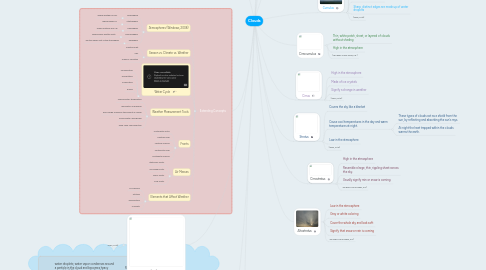
1. Nimbo- or -nimbus
1.1. Precipitation
1.1.1. Rain
1.1.1.1. water droplets; water vapor condenses around a particle in the cloud and becomes heavy enough to fall to the ground in liquid form
1.1.2. Sleet
1.1.2.1. Ice pellets that melt when they pass through a warm layer in the atmosphere. The rain then falls through a deep, freezing layer and the droplets refreeze into pellets of ice.
1.1.3. Snow
1.1.3.1. Ice crystals that have formed around a dust particle in the atmosphere. Snowflakes are made up of multiple ice crystals. Snow is formed within the cloud.
1.1.4. Freezing Rain
1.1.4.1. water droplets that fall and freeze on contact with the ground
1.1.5. Hail
1.1.5.1. hard, round ice pellets; formed when a water droplet are trapped in a freezing downdraft with in a cloud. The droplets are frozen into ice pellets. These pellets are then caught in an updraft within the cloud because they are not heavy enough to be pulled down to earth. The pellets go through this cycle multiple times, collecting more and more layers of ice until they become too heavy and fall as hail.
1.1.6. (Windows, 2008)
1.2. Cumulonimbus
1.2.1. Summer thunderstorm clouds
1.2.1.1. Strong, short, bursts of rain
1.2.1.2. Hail
1.2.1.3. Tornados
1.2.1.4. Snow
1.3. Nimbostratus
1.3.1. Long, steady rain showers
2. References
2.1. Precipitation Types: Climate Education Modules for K-12. (2013, August 9). Retrieved October 8, 2016, from http://climate.ncsu.edu/edu/k12/.preciptypes
2.2. Melisurgo, L. (2016). Sleet vs. freezing rain: What is the difference? NJ Advance Media for NJ.com. Retrieved October 5, 2016, from http://www.nj.com/weather/index.ssf/2016/02/sleet_vs_freezing_rain_how_to_tell_the_difference.html
2.3. Ten Basic Cloud Types. (n.d.). Retrieved October 7, 2016, from http://www.srh.noaa.gov/srh/jetstream/clouds/cloudwise/types.html
2.4. Tobin, Declan. (2016). Fun Cloud Facts For Kids. Easy Science for Kids. Retrieved from http://easyscienceforkids.com/all-about-clouds/
2.5. Windows to the Universe team (2008). Biomes and Ecosystems. Retrieved , from http://www.windows2universe.org
3. clouds
3.1. Tobin, 2016)
4. Extending Concepts
4.1. Atmospheres (Windows, 2008)
4.1.1. Troposphere
4.1.1.1. Where weather occurs
4.1.2. Stratosphere
4.1.2.1. Where planes fly
4.1.3. Mesosphere
4.1.3.1. Where meteors burn up
4.1.4. Thermosphere
4.1.4.1. Where space shuttle orbits
4.1.5. Exosphere
4.1.5.1. The thin upper limit of the atmosphere
4.2. Season vs. Climate vs. Weather
4.2.1. Elliptical orbit
4.2.2. Axis
4.2.3. Angle of Insolation
4.3. Water Cycle
4.3.1. Condensation
4.3.2. Precipitation
4.3.3. Evaporation
4.3.4. Runoff
4.4. Weather Measurement Tools
4.4.1. Thermometer: temperature
4.4.2. Barometer: air pressure
4.4.3. Rain Gauge: measures the amount of rainfall
4.4.4. Anemometer: wind gauge
4.4.5. Wind Vane: wind direction
4.5. Fronts
4.5.1. Continental Arctic
4.5.2. Maritime Polar
4.5.3. Maritime Tropical
4.5.4. Continental Polar
4.5.5. Continental Tropical
4.6. Air Masses
4.6.1. Stationary Fronts
4.6.2. Occluded Fronts
4.6.3. Warm Fronts
4.6.4. Cold Fronts
4.7. Elements that Affect Weather
4.7.1. Air Pressure
4.7.2. Altitude
4.7.3. Temperature
4.7.4. Humidity
5. Crosscutting Concepts
5.1. Scale, Proportion, and Quantity
5.1.1. Standard units are used to measure and describe physical quantities such as weight and volume. (5-ESS2-2)
5.2. Systems and System Models
5.2.1. A system can be described in terms of its components and their interactions. (5-ESS2-1),(5-ESS3-1)
5.3. Connections to Nature of Science
5.3.1. Science Addresses Questions About the Natural and Material World.
5.3.1.1. Science findings are limited to questions that can be answered with empirical evidence. (5-ESS3-1)
6. Cirrocumulus
6.1. Thin, white patch, sheet, or layered of clouds without shading
6.2. High in the atmosphere
6.3. (Ten Basic Cloud Types, n.d.)
7. Cirrostratus
7.1. High in the atmosphere
7.2. Resemble a large, thin, rippling sheet across the sky.
7.3. Usually signify rain or snow is coming.
7.4. Ten Basic Cloud Types, n.d.)
8. Cumulus
8.1. Large and fluffy like cotton balls
8.2. Signify good/fair weather
8.3. Low in the atmosphere
8.4. Sharp, distinct edges are made up of water droplets
8.5. (Tobin, 2016)
9. Cirrus
9.1. High in the atmosphere
9.2. Made of ice crystals
9.3. Signify a change in weather
9.4. (Tobin, 2016)
10. Stratus
10.1. Covers the sky like a blanket
10.2. Cause cool temperatures in the day and warm temperatures at night.
10.2.1. These types of clouds act as a shield from the sun, by reflecting and absorbing the sun's rays.
10.2.2. At night the heat trapped within the clouds warms the earth.
10.3. Low in the atmosphere
10.4. (Tobin, 2016)
11. Standards
11.1. 5.E.1 Understand weather patterns and phenomena, making connections to the weather in a particular place and time.
11.1.1. 5.E.1.1 Compare daily and seasonal changes in weather conditions (including wind speed and direction, precipitation, and temperature) and patterns.
11.1.2. 5.E.1.2 Predict upcoming weather events from weather data collected through observation and measurements.
11.1.3. 5.E.1.3 Explain how global patterns such as the jet stream and water currents influence local weather in measurable terms such as temperature, wind direction and speed, and precipitation.
